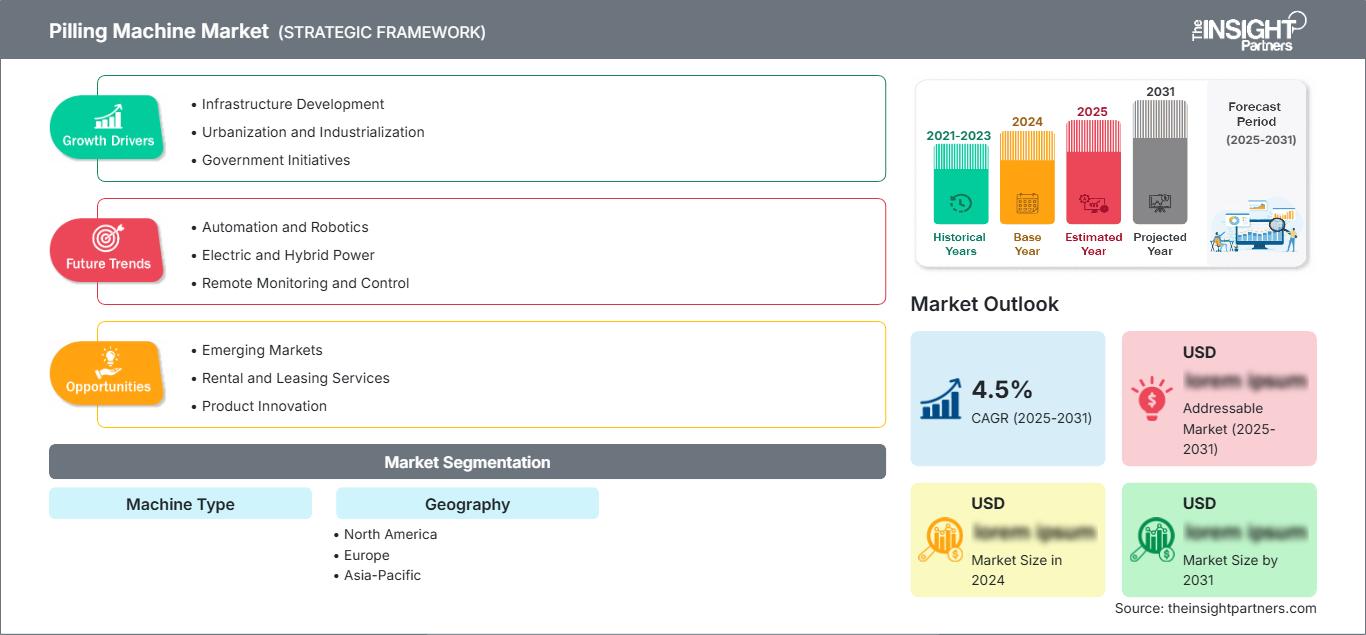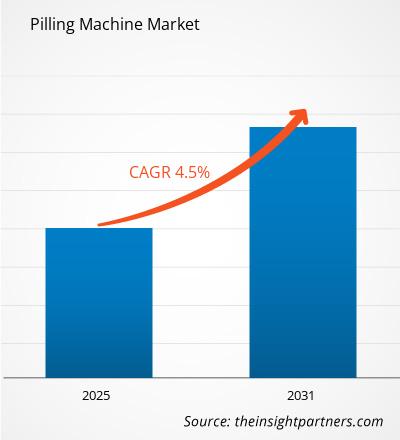Se espera que el mercado de máquinas de pilling registre una CAGR de 4,5% entre 2025 y 2031, con un tamaño de mercado que se expandirá de US$ XX millones en 2024 a US$ XX millones en 2031.
El informe está segmentado por tipo de máquina. El análisis global se desglosa a nivel regional y por países principales. La evaluación del mercado se presenta en dólares estadounidenses para el análisis segmentario mencionado.
Propósito del Informe
El informe "Mercado de Máquinas de Pilling" de The Insight Partners busca describir el panorama actual y el crecimiento futuro, los principales factores impulsores, los desafíos y las oportunidades. Esto proporcionará información a diversas partes interesadas del negocio, como:
- Proveedores/fabricantes de tecnología: Para comprender la dinámica cambiante del mercado y conocer las oportunidades potenciales de crecimiento, lo que les permitirá tomar decisiones estratégicas informadas.
- Inversores: Realizar un análisis exhaustivo de tendencias respecto a la tasa de crecimiento del mercado, las proyecciones financieras del mercado y las oportunidades que existen en toda la cadena de valor.
- Órganos reguladores: Regular las políticas y las actividades policiales en el mercado con el objetivo de minimizar el abuso, preservar la confianza de los inversores y defender la integridad y estabilidad del mercado.
Segmentación del mercado de máquinas de pilling
Tipo de máquina
Obtendrá personalización en cualquier informe, sin cargo, incluidas partes de este informe o análisis a nivel de país, paquete de datos de Excel, así como también grandes ofertas y descuentos para empresas emergentes y universidades.
Mercado de máquinas de pilling: Perspectivas estratégicas

-
Obtenga las principales tendencias clave del mercado de este informe.Esta muestra GRATUITA incluirá análisis de datos, desde tendencias del mercado hasta estimaciones y pronósticos.
Factores que impulsan el crecimiento del mercado de máquinas de pilling
- Desarrollo de infraestructura: El aumento global de proyectos de infraestructura, incluidos caminos, puentes, aeropuertos y ferrocarriles, está impulsando la demanda de máquinas de pilotaje para establecer cimientos sólidos.
- Urbanización e industrialización: La rápida urbanización e industrialización están creando nuevos sitios de construcción, que requieren soluciones de pilotaje eficientes y confiables.
- Iniciativas gubernamentales: Las inversiones gubernamentales en proyectos de infraestructura y vivienda impulsan el mercado de máquinas para pilotar.
Tendencias futuras del mercado de máquinas de pilling
- Automatización y robótica: la creciente adopción de la automatización y la robótica en la construcción mejorará la eficiencia, la seguridad y la productividad, lo que conducirá a un aumento en la demanda de máquinas de pilotaje autónomas y operadas de forma remota.
- Energía eléctrica e híbrida: el creciente énfasis en la sostenibilidad y la reducción de las emisiones de carbono impulsará el desarrollo de máquinas de pilotaje eléctricas e híbridas, que ofrecerán soluciones más limpias y eficientes.
- Monitoreo y control remoto: el monitoreo en tiempo real y el control remoto mejoran la eficiencia operativa y la seguridad.
Oportunidades de mercado para máquinas de pilling
- Mercados emergentes: Los países en desarrollo con sólidos planes de desarrollo de infraestructura, como India, China y las naciones del sudeste asiático, presentan importantes oportunidades de crecimiento para los fabricantes de máquinas de pilotaje.
- Servicios de alquiler y arrendamiento: El modelo de negocio de alquiler y arrendamiento ofrece una solución flexible y rentable para las empresas de construcción, impulsando la demanda de servicios de alquiler de máquinas de pilotaje.
- Innovación de productos: El desarrollo de máquinas de pilotaje avanzadas con capacidades y características mejoradas satisface diversos requisitos del proyecto.
Perspectivas regionales del mercado de máquinas formadoras de bolitas
Los analistas de The Insight Partners han explicado detalladamente las tendencias regionales y los factores que influyen en el mercado de máquinas de pilling durante el período de pronóstico. Esta sección también analiza los segmentos y la geografía del mercado de máquinas de pilling en América del Norte, Europa, Asia Pacífico, Oriente Medio y África, y América del Sur y Central.
Alcance del informe de mercado de máquinas de pilling
| Atributo del informe | Detalles |
|---|---|
| Tamaño del mercado en 2024 | US$ XX millones |
| Tamaño del mercado en 2031 | US$ XX millones |
| CAGR global (2025-2031) | 4,5% |
| Datos históricos | 2021-2023 |
| Período de pronóstico | 2025-2031 |
| Segmentos cubiertos | Por tipo de máquina |
| Regiones y países cubiertos |
América del norte
|
| Líderes del mercado y perfiles de empresas clave |
|
Densidad de actores del mercado de máquinas de pilling: comprensión de su impacto en la dinámica empresarial
El mercado de las máquinas de pilling está creciendo rápidamente, impulsado por la creciente demanda del usuario final debido a factores como la evolución de las preferencias del consumidor, los avances tecnológicos y un mayor conocimiento de los beneficios del producto. A medida que aumenta la demanda, las empresas amplían su oferta, innovan para satisfacer las necesidades del consumidor y aprovechan las tendencias emergentes, lo que impulsa aún más el crecimiento del mercado.

- Obtenga una descripción general de los principales actores clave del mercado de máquinas de pilling
Puntos clave de venta
- Cobertura integral: el informe cubre de manera integral el análisis de productos, servicios, tipos y usuarios finales del mercado de máquinas de pilling, proporcionando un panorama holístico.
- Análisis de expertos: el informe se compila con base en el conocimiento profundo de expertos y analistas de la industria.
- Información actualizada: El informe asegura relevancia comercial debido a su cobertura de información reciente y tendencias de datos.
- Opciones de personalización: este informe se puede personalizar para satisfacer los requisitos específicos del cliente y adaptarse adecuadamente a las estrategias comerciales.
Por lo tanto, el informe de investigación sobre el mercado de máquinas de pilling puede ayudar a descifrar y comprender el panorama de la industria y sus perspectivas de crecimiento. Si bien existen algunas preocupaciones válidas, las ventajas generales de este informe tienden a superar las desventajas.
- Análisis histórico (2 años), año base, pronóstico (7 años) con CAGR
- Análisis PEST y FODA
- Tamaño del mercado, valor/volumen: global, regional y nacional
- Industria y panorama competitivo
- Conjunto de datos de Excel
Informes recientes
Informes relacionados
Testimonios
Razón para comprar
- Toma de decisiones informada
- Comprensión de la dinámica del mercado
- Análisis competitivo
- Información sobre clientes
- Pronósticos del mercado
- Mitigación de riesgos
- Planificación estratégica
- Justificación de la inversión
- Identificación de mercados emergentes
- Mejora de las estrategias de marketing
- Impulso de la eficiencia operativa
- Alineación con las tendencias regulatorias






















 Obtenga una muestra gratuita para - Mercado de máquinas de pilling
Obtenga una muestra gratuita para - Mercado de máquinas de pilling